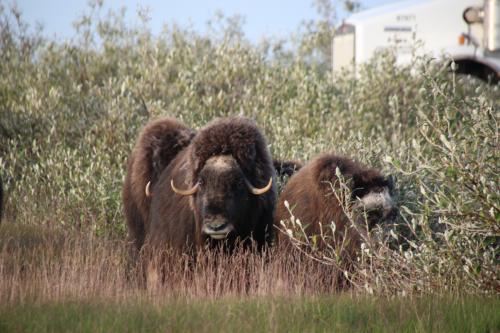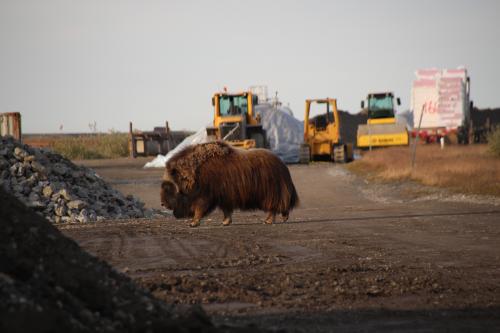As I mentioned yesterday, wildlife sightings are one of the best parts of driving the Dalton Highway. On our way up to Deadhorse Camp, we had been driving for about 5 hours but had also stopped to do some measurements at VIPER sites (I'll talk about these sites in another post). At the 20 mile mark, it was getting pretty late, but we saw two vehicles pulled over on the barely existent shoulder. As we slowed down, we looked out into the tundra and saw some piles of dirt, but on second look, some of them seemed to be moving. After a many-point turn (the truck has a tough time turning in 4-wheel drive) we were also on the shoulder and I convinced Christina we should hike out and see what was up.
 Would you walk into the tundra for Muskoxen if you saw this van? Yes, it says "Free Candy".
Would you walk into the tundra for Muskoxen if you saw this van? Yes, it says "Free Candy".
 Are these dirt piles or muskoxen? We'll have to explore to find out.
Are these dirt piles or muskoxen? We'll have to explore to find out.
 A clue! Signs pointed to *not* a pile of dirt.
A clue! Signs pointed to *not* a pile of dirt.
Once we were were out 300 meters or so, we could see a herd of about 10 muskoxen; males, females, and juveniles. We also met our two new friends, Gottfried and Robert. Gottfried is from Cologne, Germany and he has been traveling around Alaska for the last four months to photograph wildlife. Robert lives in Healy (just outside of Denali) and met Gottfried during one of his Alaska adventures and decided to join him during his trip up the Dalton. The two were camping in their trucks and had been following this pack of muskoxen for over four days. Robert and Gottfried welcomed us right away, telling us about what they had observed from the herd and letting us get great shots of the muskoxen. We also swapped Alaska stories while we watched the herd eat for over two hours.
 Our new friends – Robert and Gottfried.
Our new friends – Robert and Gottfried.
Muskoxen have been in Alaska for a very long time; they are from the Pleistocene era and came to Alaska by migrating over the land bridge. In comparison to pictures you may have seen, muskoxen are shorter in person, but they are stocky and very heavy. One of the best parts of watching muskoxen is their hair; they have a long skirt of dark-brown guard hairs (think adorable cousin Itt) and under the guard hairs they have a layer of fine light-brown wool that is highly insulated (note to self: google Qiviut sweaters).
 Look at that hair!
Look at that hair!
Another distinctive feature of muskoxen are their horns. Both males and females have horns, however males' horns meet in center to form a massive "boss" used in fights for access to females for breeding.
 Male muskoxen – thicker horns.
Male muskoxen – thicker horns.
 Female muskoxen – smaller horns.
Female muskoxen – smaller horns.
Muskoxen are vegetarians; eating sedge and willow shoots. A cool thing I learned about muskoxen is how they work as a team to defend their herd against wolves. Muskoxen work together in defense, forming a circle around younger muskoxen and attempt to gore the wolf anytime it approaches.
 Two muskoxen.
Two muskoxen.
Muskoxen are considered a successful conservation story after over-hunting at the turn of century wiped them out from Alaska. They were successfully reintroduced in 1930s when 34 animals were purchased from Greenland and reintroduced in stages to different regions of the North Slope.
 Imagine Alaska without these wonderful animals. :(
Imagine Alaska without these wonderful animals. :(
This will probably stand as one of my favorite PolarTREC memories; the rare and unexpected sighting of a herd when you least expect it (aka not on the schedule and maybe when you are supposed to be doing thaw depth), a prolonged chance to view wildlife undisturbed, and new friends to share it with.
 Another shot as the sun sets.
Another shot as the sun sets.

Comments
Add new comment